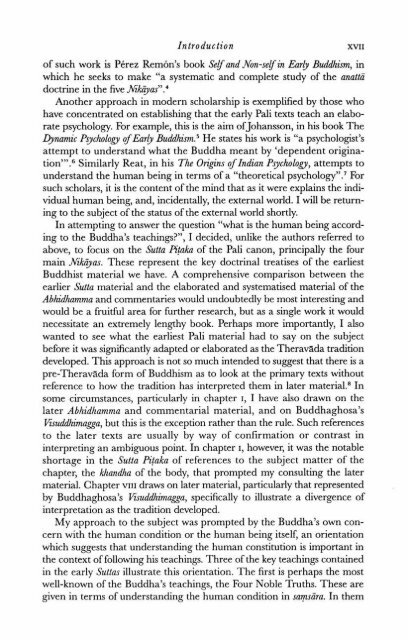Identity and Experience_Hamilton_1996
Identity and Experience_Hamilton_1996
Identity and Experience_Hamilton_1996
Create successful ePaper yourself
Turn your PDF publications into a flip-book with our unique Google optimized e-Paper software.
Introduction<br />
XVII<br />
of such work is Perez Rem6nYs book Sey<strong>and</strong> ,Won-seyin Ear& Buddhism, in<br />
which he seeks to make "a systematic <strong>and</strong> complete study of the an at^<br />
doctrine in the five Nihyas".*<br />
Another approach in modern scholarship is exemplified by those who<br />
have concentrated on establishing that the early Pali texts teach an elaborate<br />
psychology. For example, this is the aim ofJohansson, in his book The<br />
Dynamic Psychology ofEarb He states his work is "a psychologist's<br />
attempt to underst<strong>and</strong> what the Buddha meant by 'dependent originati~n'".~<br />
Similarly Reat, in his The Orz@ns of Indian Psycholog;y, attempts to<br />
underst<strong>and</strong> the human being in terms of a "theoretical psychology".' For<br />
such scholars, it is the content of the mind that as it were explains the individual<br />
human being, <strong>and</strong>, incidentally, the external world. I will be returning<br />
to the subject of the status of the external world shortly.<br />
In attempting to answer the question "what is the human being according<br />
to the Buddha's teachings?", I decided, unlike the authors referred to<br />
above, to focus on the Sutta Pitaka of the Pali canon, principally the four<br />
main Nik@as. These represent the key doctrinal treatises of the earliest<br />
Buddhist material we have. A comprehensive comparison between the<br />
earlier Sutta material <strong>and</strong> the elaborated <strong>and</strong> systematised material of the<br />
Abhidhamma <strong>and</strong> commentaries would undoubtedly be most interesting <strong>and</strong><br />
would be a fruitful area for further research, but as a single work it would<br />
necessitate an extremely lengthy book. Perhaps more importantly, I also<br />
wanted to see what the earliest Pali material had to say on the subject<br />
before it was significantly adapted or elaborated as the Theravada tradition<br />
developed. This approach is not so much intended to suggest that there is a<br />
pre-Theravada form of Buddhism as to look at the primary texts without<br />
reference to how the tradition has interpreted them in later material.' In<br />
some circumstances, particularly in chapter I? I have also drawn on the<br />
later Abhidhamma <strong>and</strong> commentarial material, <strong>and</strong> on Buddhaghosa's<br />
Ks~&imagga, but this is the exception rather than the rule. Such references<br />
to the later texts are usually by way of confirmation or contrast in<br />
interpreting an ambiguous point. In chapter I, however, it was the notable<br />
shortage in the Sutta Pitaka of references to the subject matter of the<br />
chapter, the kh<strong>and</strong>ha of the body, that prompted my consulting the later<br />
material. Chapter VIII draws on later material, particularly that represented<br />
by Buddhaghosa's Visuddhimagga, specifically to illustrate a divergence of<br />
interpretation as the tradition developed.<br />
My approach to the subject was prompted by the Buddha's own concern<br />
with the human condition or the human being itself, an orientation<br />
which suggests that underst<strong>and</strong>ing the human constitution is important in<br />
the context of following his teachings. Three of the key teachings contained<br />
in the early Suttas illustrate this orientation. The first is perhaps the most<br />
well-known of the Buddha's teachings, the Four Noble Truths. These are<br />
given in terms of underst<strong>and</strong>ing the human condition in samsZra. In them


